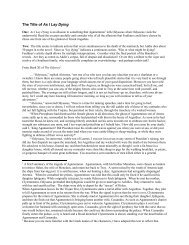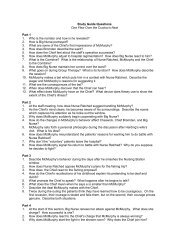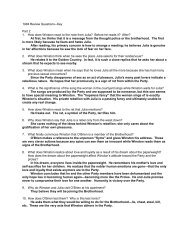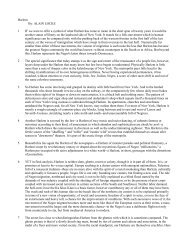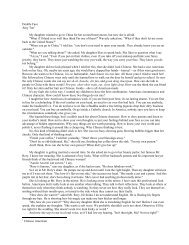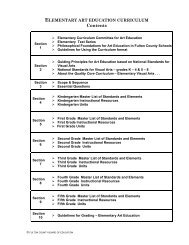CATCH-22 Study Guide - Fulton County Schools
CATCH-22 Study Guide - Fulton County Schools
CATCH-22 Study Guide - Fulton County Schools
Create successful ePaper yourself
Turn your PDF publications into a flip-book with our unique Google optimized e-Paper software.
<strong>CATCH</strong>-<strong>22</strong> <strong>Study</strong> <strong>Guide</strong><br />
Chapter 1: The Texan<br />
1. Why does Yossarian “fall in love” (Pg. 1) with the chaplain?<br />
2. How is antithesis used to introduce the idea of an inefficient medical establishment within the military?<br />
3. What is the effect of the simile comparing the Texan to “someone in Technicolor”? (Pg. 17)<br />
4. What reaction do the soldiers in the ward have to the Texan?<br />
5. What words express the lifelessness of the soldier in white on page 18?<br />
6. What details suggest the balance of power in the relationship between Yossarian and the chaplain?<br />
Chapter 2: Clevinger<br />
1. Is it a paradox when the narrator says that the Texan is “really very sick”? (Pg. 25) Why or why not?<br />
2. Pages 25 and 26 contain the dispute between Yossarian and Clevinger about whether Yossarian is insane. Is<br />
Yossarian paranoid, or are his fears justified?<br />
3. How are the conventions of normal language twisted on pages 26 and 27 to express Yossarian’s difference from<br />
the archetypal soldier?<br />
Chapter 3: Havermeyer<br />
1. How is repetition used to foreshadow Orr’s eventual fate on page 34?<br />
2. What is ironic about the initial battles for turf between General Dreedle and General Peckem?<br />
3. Explain the comparison between the pilots who have finished fifty missions and “useless young men in a<br />
depression.”(Pg. 36)<br />
4. Explain how you know that General Peckem chose the wrong person to generate enthusiasm for the USO visits.<br />
5. What details show Havermeyer’s insanity? How do these characteristics help him as a bombardier?<br />
6. What happens to Hungry Joe during one of Havermeyer’s mouse-shootings?<br />
Chapter 4: Doc Daneeka<br />
1. Which of Doc Daneeka’s physical characteristics express his declining spirit?<br />
2. Explain Dunbar’s definition of age.<br />
Chapter 5: Chief White Halfoat<br />
1. What does Doc Daneeka consider to be his most valuable medical instruments? What does this tell the reader<br />
about him?<br />
2. Explain the two different descriptions of Chief White Halfoat on page 52.<br />
3. What is ironic about Chief White Halfoat’s outrage over discrimination against Indians?<br />
4. Explain the play on words used to describe the expulsion of Chief White Halfoat’s cousins to Canada.<br />
5. In your own words, give a definition of Catch-<strong>22</strong>, as explained on page 55.<br />
6. What is ironic about the diction used in Yossarian’s description of Catch-<strong>22</strong>?<br />
7. How is personification used to describe the airplanes on page 57?<br />
8. What is the effect of the oxymoron at the bottom of page 57?<br />
9. What literary devices are used to heighten the sense of horror in Yossarian’s mind on page 58?<br />
10. What central event of this novel is first remembered in this chapter?<br />
Chapter 6: Hungry Joe<br />
1. What devices are used on page 61 to give an especially vivid description of Hungry Joe’s mania?<br />
2. What is the cause of Hungry Joe’s nightmares?<br />
3. What is the effect of the allusion on page 64?<br />
4. Where does Catch-<strong>22</strong> make its second appearance?<br />
5. Contrast Yossarian’s and Hungry Joe’s responses to the raising of the mission requirement to 55?<br />
6. Compare Wintergreen’s lack of sympathy towards Yossarian with Yossarian’s own sense of self-preservation.<br />
Chapter 7: McWatt<br />
1. How is repetition used to emphasize absurdity in this chapter?<br />
2. What is the figurative significance of Corporal Snark poisoning the squadron with soap?<br />
3. What is ironic about Milo’s desire to move Corporal Snark into administration?<br />
4. What is ironic about Milo’s appearance? How does this apply to his moral character?<br />
5. What is absurd about the “profit” Milo delivers to Yossarian and McWatt?
Chapter 8: Lieutenant Scheisskopf<br />
1. Explain the allusion on page 77.<br />
2. Explain the comparison of Scheisskopf to King Lear.<br />
3. On page 79, the narrator describes Yossarian’s love for Dori Duz. Why does he love her? Compare this love to<br />
Yossarian’s love for the chaplain.<br />
4. What is Yossarian’s opinion of the parade contest? What does this tell the reader about his suitability for the<br />
military?<br />
5. What is tragic about Lt. Scheisskopf’s mania for parades?<br />
6. What does Clevinger learn at his trail?<br />
Chapter 9: Major Major Major Major<br />
1. Explain the allusion on page 92.<br />
2. Explain the play on words found on page 93.<br />
3. How is the description of Major Major’s father satirical?<br />
4. Why do Major Major’s elders feel such antipathy toward him?<br />
5. Explain the allusion on page 96.<br />
6. What imagery and diction are used to express the change wrought by Major Major’s promotion to squadron<br />
commander?<br />
7. How does the return of the C.I.D. investigator emphasize the theme of the book?<br />
8. Explain the play on words on page 107.<br />
Chapter 10: Wintergreen<br />
1. Explain the first two sentences in this chapter.<br />
2. Explain the third reference to Catch-<strong>22</strong>, found on page 115.<br />
3. What is the rhetorical purpose of the curious case of Mudd?<br />
4. What rhetorical devices are used to express the men’s fear of the coming trip to Bologna on page 118?<br />
5. What do Dr. Stubbs and Yossarian have in common?<br />
Chapter 11: Captain Black<br />
1. Explain why Captain Black takes such joy in the upcoming mission to Bologna.<br />
2. What is ironic about the loyalty oath?<br />
3. Explain the fourth reference to Catch-<strong>22</strong>, on page 124.<br />
4. What is ironic about the way Major _____ de Coverley ends the Glorious Loyalty Oath Crusade?<br />
Chapter 12: Bologna<br />
1. How is repetition used on pages 129 and 130? What is the rhetorical effect?<br />
Chapter 13: Major _____ de Coverley<br />
1. What is ironic about the general confusion as to Major _____ de Coverley’s identity?<br />
2. Why does Yossarian love the maid with the lime-colored panties?<br />
3. What is the effect of the alliteration on page 147?<br />
4. Why does Yossarian get a medal and a promotion?<br />
Chapter 14: Kid Sampson<br />
1. On the first page of this chapter, Yossarian is described as “brave.” How has his bravery changed?<br />
2. What is the effect of the images of decay in the last paragraph of page 152 and on page 153?<br />
3. What literary term is represented when comparing the fungus and Yossarian?<br />
Chapter 15: Piltchard & Wren<br />
1. How does the syntax in the first full paragraph on page 156 express narrative point of view?<br />
2. What is the effect of comparing the sound of the engines to that of a “fat, lazy fly”?(Pg. 156)<br />
3. How is Aarfy’s moral character hinted at in this chapter?<br />
4. What images are used to describe the planes as they struggle to escape Bologna? What is the effect of those<br />
images?
Chapter 16: Luciana<br />
1. Describe the rapport that develops between Yossarian and Luciana.<br />
2. What is the effect of the alliteration used to describe the girl in the orange satin blouse on page 165?<br />
3. How is Aarfy’s attempt to improve the girl in the orange blouse morally used to foreshadow his actual depravity?<br />
4. How are Yossarian’s feelings for Luciana the fifth appearance of Catch-<strong>22</strong> in the story?<br />
5. Why does Yossarian have sex with the maid in the lime-colored panties at the end of the chapter?<br />
Chapter 17: The Soldier in White<br />
1. What is the effect of the personification of Death on pages 175 and 176?<br />
2. What is the effect of the repetition the paragraph that begins, “They didn’t take itY” on page 176?<br />
3. Why does Yossarian hate Nurse Cramer?<br />
4. What is the effect of the alliteration and repetition on page 182?<br />
5. Explain the sixth appearance of Catch-<strong>22</strong>, on page 184.<br />
Chapter 18: The Soldier Who Saw Everything Twice<br />
1. What is the effect of the reference to the Oedipus story on page 186?<br />
2. What is the significance of the soldier who sees everything twice?<br />
3. What are the cynical elements of Yossarian’s encounter with the family coming to see another soldier?<br />
Chapter 19: Colonel Cathcart<br />
1. How is juxtaposition used to express the paradox that is Colonel Cathcart?<br />
2. Explain the implications of referring to Colonel Cathcart as “his own sarcophagus.” (Pg. 198)<br />
3. Compare and contrast Colonel Cathcart to Yossarian.<br />
4. How does Colonel Cathcart demonstrate an absolute ignorance about matters of faith?<br />
Chapter 20: Corporal Whitcomb<br />
1. What is the purpose of the chaplain’s isolation?<br />
2. Explain Corporal Whitcomb’s behavior toward the chaplain.<br />
Chapter 21: General Dreedle<br />
1. What can the reader learn about Colonel Cathcart from his “mature and systematic evaluation of the entire<br />
military situation”? (Pg. <strong>22</strong>2)<br />
2. How is General Dreedle’s position in the army an example of dramatic irony?<br />
3. What impression does the reader get from the description of General Dreedle’s nurse, and how does word choice<br />
contribute?<br />
4. Summarize General Dreedle’s method of managing his subordinates.<br />
5. Explain Yossarian’s love for the general’s nurse.<br />
6. Why do the other men in the room echo Yossarian’s depraved moaning?<br />
7. How does Colonel Korn’s speech to the men have ironic consequences?<br />
Chapter <strong>22</strong>: Milo the Mayor<br />
1. Why does Dobbs ask for Yossarian’s help in murdering Colonel Cathcart?<br />
2. Why is the reader told about the absurd number of titles and honors that Milo has garnered throughout the Middle<br />
East and Africa?<br />
Chapter 23: Nately’s Old Man<br />
1. How does Aarfy’s attitude toward the three prostitutes foreshadow coming events?<br />
2. Nately becomes irate when the old man suggests that America will not last forever, and that it is better to lose a<br />
war than to win one; the narrator terms the old man a “sly and sinful assailant” spewing out “obnoxious calumnies.”<br />
(Pg. 254) Why does Nately consider the old man sinful, and in what way are the old man’s statements untrue?<br />
3. Why does the old man choose an American Beauty rose to throw at Major _____ de Coverley, and an edelweiss<br />
for the German Oberstleutnant?<br />
4. Why does the old man remind Nately of his father?
Chapter 24: Milo<br />
1. Explain the reversal of a cliché in the first paragraph of this chapter.<br />
2. Why does Milo have his mechanics repaint the borrowed planes?<br />
3. How does Milo avoid bankruptcy?<br />
4. After Snowden’s death, why doesn’t Yossarian want to wear any clothes?<br />
5. Why is it ironic that Milo wants to feed the soldiers chocolate-covered cotton?<br />
Chapter 25: The Chaplain<br />
1. What is one possible metaphorical significance of the black thread that Sgt. Whitcomb is using to sew his patch on<br />
his uniform?<br />
2. What is ironically humorous about this statement from Colonel Cathcart: “He says you’ve got no initiative either.<br />
You’re not going to disagree with me, are you?”(Pg. 291)<br />
3. Where does the chaplain find encouragement to continue in his religious faith?<br />
Chapter 26: Aarfy<br />
1. Contrast Nately and Aarfy’s definitions of true love.<br />
2. Explain why Nurse Cramer is so upset with Yossarian, even before he tells her to go away.<br />
Chapter 27: Nurse Duckett<br />
1. Why does Yossarian sexually assault Nurse Duckett?<br />
2. How do Yossarian and Dunbar avoid accountability for their attack on the nurse?<br />
3. In what ways is Major Sanderson used to make fun of psychoanalysis?<br />
4. Major Sanderson thinks that Yossarian should be “taken outside and shot.” (Pg. 309) How is this both similar to<br />
and different from General Dreedle’s order to shoot Major Danby?<br />
5. What is the role and significance of the mysterious Anthony F. Fortiori? Explain the situational irony of<br />
Sanderson’s thinking.<br />
6. What is the one problem that Major Sanderson finds with Yossarian that makes him crazy?<br />
Chapter 28: Dobbs<br />
1. Explain Dobbs’ change of heart about killing Colonel Cathcart.<br />
2. What is ironic about Yossarian’s patronizing concern for Orr?<br />
3. Explain the effect of the diction in Yossarian’s fantasy about the countess and her daughter-in-law on page 325.<br />
Chapter 29: Peckem<br />
1. Why does General Peckem feel that “his polish just [isn’t] getting across”? (Pg. 330)<br />
2. Explain why General Peckem seems to enjoy creating disharmony among his subordinates.<br />
3. Explain Colonel Korn’s treatment of Havermeyer in the briefing.<br />
4. What is ridiculous about the strategy of this particular bombing mission?<br />
Chapter 30: Dunbar<br />
1. What kind of relationship does Yossarian have with Nurse Duchett in this chapter?<br />
2. What is the farcical element of McWatt’s suicide?<br />
Chapter 31: Mrs. Daneeka<br />
1. What humorous elements contribute to the farce of Doc Daneeka’s “death”?<br />
Chapter 32: Yo-Yo’s Roomies<br />
1. What is the effect of the simile describing Kid Sampson’s amputated legs?<br />
2. Why does Yossarian have such antipathy toward his new roommates?<br />
Chapter 33: Nately’s Whore<br />
1. Explain the significance of Yossarian’s sexual escapades in Rome.<br />
2. Why does Nately’s whore finally fall in love with him? What changes does this make within Nately? Do these<br />
changes actually make him crazy, as all the other characters seem to say?<br />
Chapter 34: Thanksgiving<br />
1. Explain the play on words regarding the chaplain’s decision to lie his way into the hospital.<br />
2. Why does Dunbar vanish?
Chapter 35: Milo the Militant<br />
1. What is the effect of the imagery describing the planes on page 387?<br />
Chapter 36: The Cellar<br />
1. Contrast the chaplain’s and Sergeant Whitcomb’s responses to the losses in Dobbs’ plane.<br />
2. What is the irony of choosing this point in time to interrogate the chaplain?<br />
3. What sentence best encapsulates the farce of the chaplain’s interrogation?<br />
Chapter 37: General Scheisskopf<br />
1. What is ironic about General Peckem’s appointment as wing commander?<br />
Chapter 38: Kid Sister<br />
1. Explain the allusion on page 403.<br />
2. Why is Nately’s whore obsessed with killing Yossarian?<br />
3. Why are so many different people, including the gung-ho Havermeyer and Appleby, coming up to Yossarian in<br />
the dark now that he is openly rebelling against orders?<br />
Chapter 39: The Eternal City<br />
1. What is “The Eternal City” a reference to?<br />
2. What is the seventh, and most outrageous, manifestation of Catch-<strong>22</strong>?<br />
3. What imagery is used to show the twisted depravity of the materialistic state?<br />
4. What is the symbolism of the Allied soldier having convulsions?<br />
5. Explain the allusion on page 425.<br />
6. What is the significance of the fact that Yossarian keeps tripping over evidence of brutality (broken teeth, the feet<br />
of a woman) as he walks through the streets?<br />
7. What solace does Yossarian ultimately decide to seek to help him put the brutality out of his mind?<br />
8. How is suspense built and increased between Yossarian’s arrest and his arrival in Colonel Cathcart’s office? What<br />
happens to this suspense?<br />
Chapter 40: Catch-<strong>22</strong><br />
1. Contrast the approaches that Colonel Korn and Colonel Cathcart take toward Yossarian.<br />
2. What is the deal that Colonel Cathcart and Colonel Korn offer to Yossarian? What happens at the very end of the<br />
chapter?<br />
Chapter 41: Snowden<br />
1. What unusual combination of smells is used to express the ambiguity of Yossarian’s situation?<br />
2. What is the significance of the “strange man with a mean face” who keeps showing up and telling Yossarian,<br />
“We’ve got your pal, buddy. We’ve got your pal.” (Pg. 442)<br />
3. What is the “official” story of Yossarian’s injury?<br />
4. What is the most dramatic literary device used during the operation on Yossarian and during his time in the plane<br />
trying to save Snowden?<br />
5. Explain the allusion found in the reading of Snowden’s “entrails.” (Pg. 450)<br />
Chapter 42: Yossarian<br />
1. At the beginning of the chapter, Yossarian has decided to renege on his deal with the colonels.<br />
2. What unforeseen consequence does Major Danby warn him about?<br />
3. Why has Yossarian lost the ability to believe in the ideals of patriotism?<br />
4. Explain whether you think that Yossarian is a coward or a hero for deserting and following Orr to Sweden.




